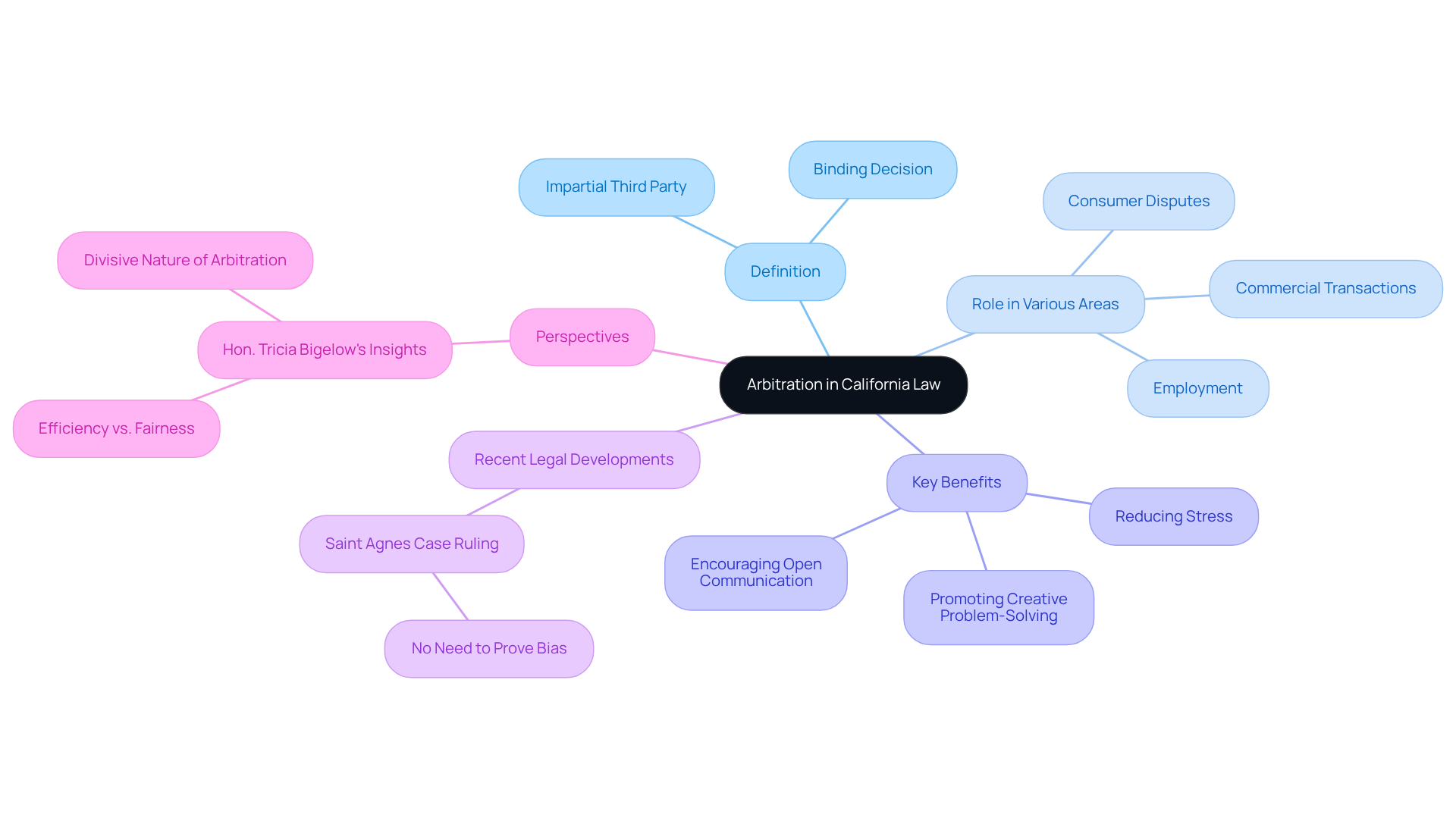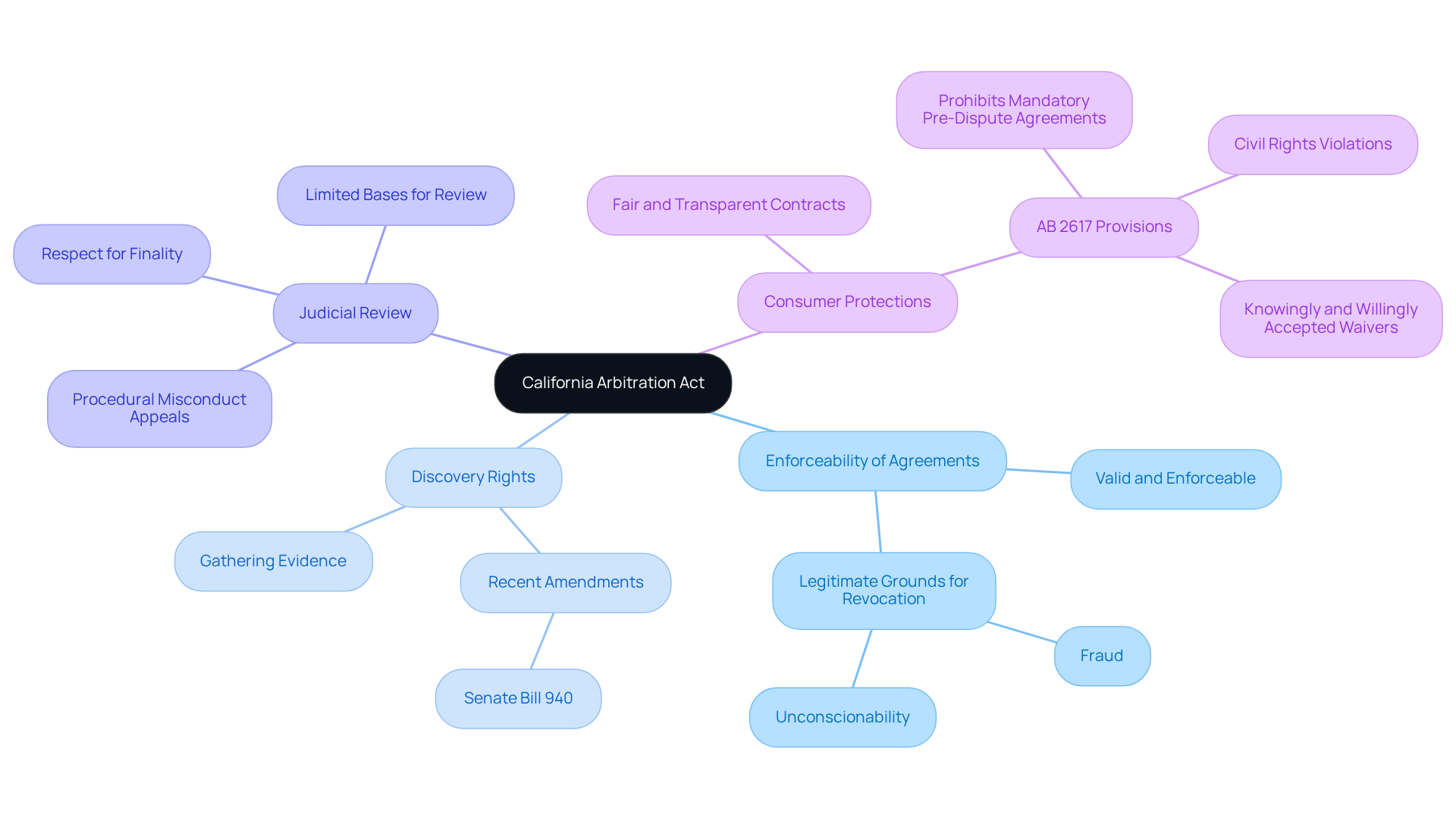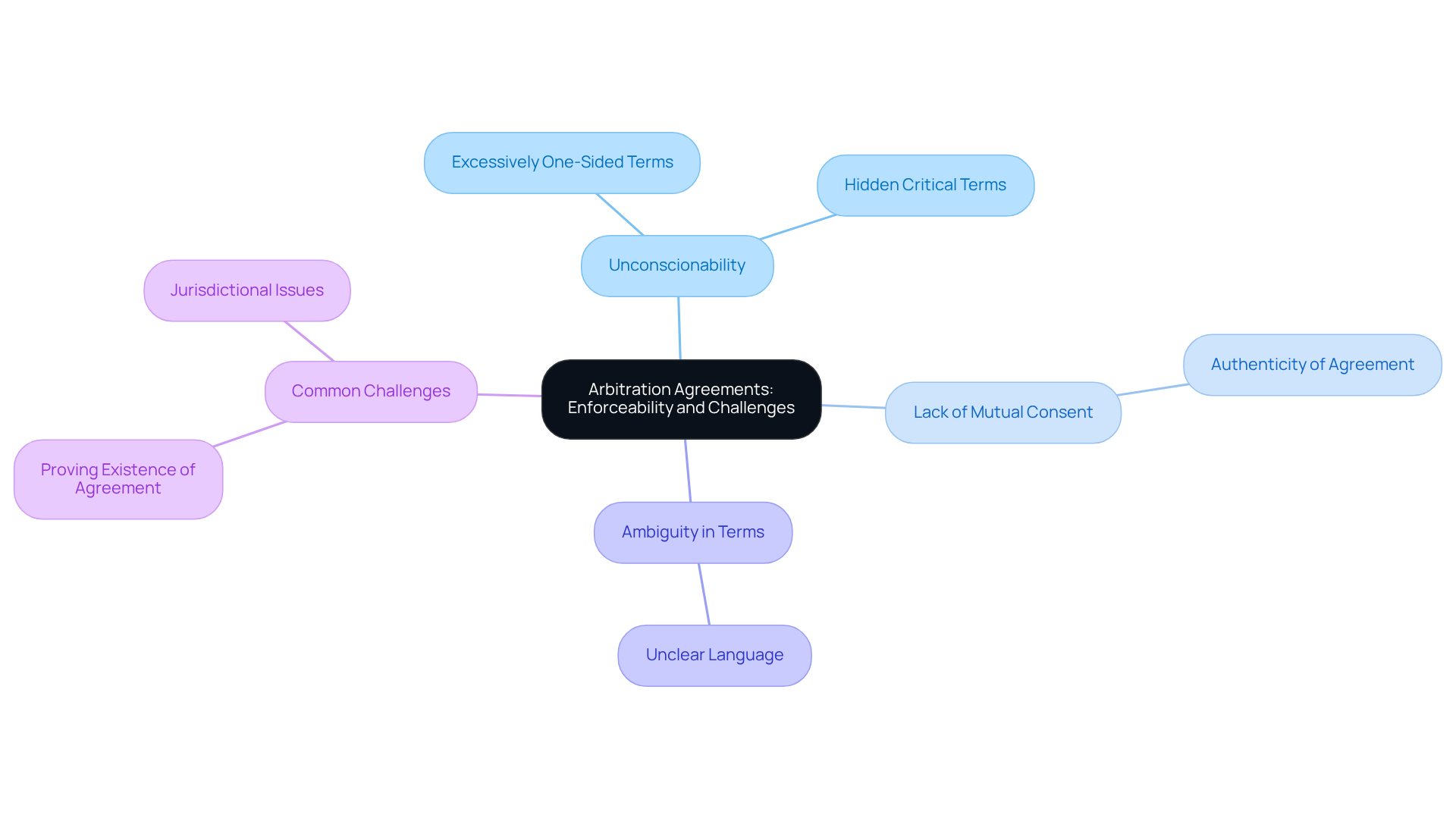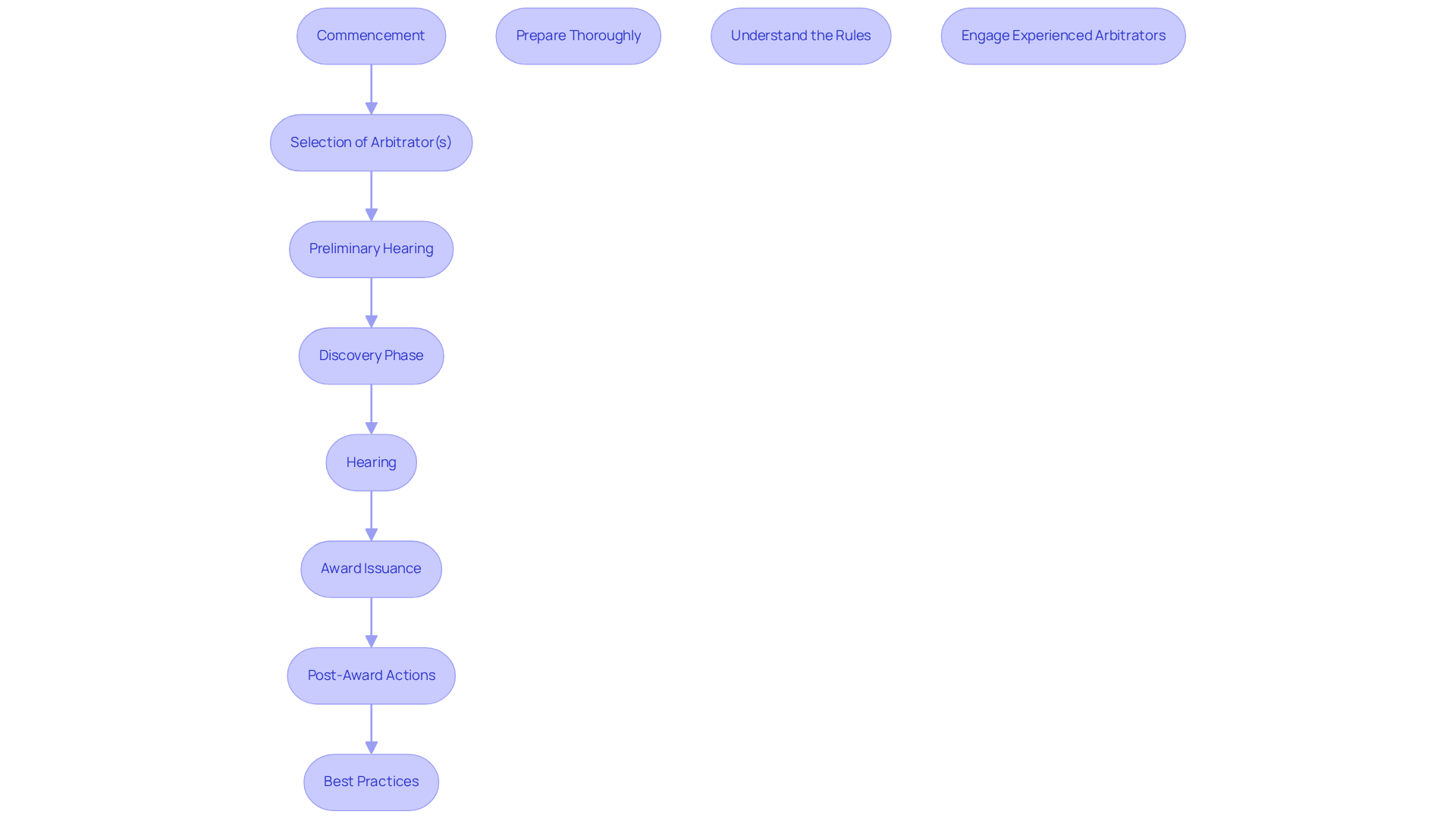
Master the California Arbitration Act: Key Insights and Steps
Overview
In today's world, navigating disputes can be daunting. The California Arbitration Act stands as a beacon of hope, facilitating efficient and fair resolution outside of traditional court systems. By understanding its key provisions, we can appreciate how it aims to support individuals like you in resolving conflicts with care and respect.
Have you ever felt overwhelmed by the complexities of legal processes? The Act highlights the enforceability of arbitration agreements, expanded discovery rights, and essential consumer protections. These elements work together to create a balanced environment where your rights are safeguarded.
Imagine a scenario where you can resolve conflicts in a supportive setting, free from the stress of courtrooms. This is the promise of the California Arbitration Act. It seeks to nurture a space where disputes can be handled with compassion, ensuring that your voice is heard and valued.
As we explore these benefits, consider how this approach can transform your experience in resolving conflicts. The California Arbitration Act not only prioritizes efficiency but also emphasizes the importance of fairness and respect in every step of the process. Together, we can advocate for a system that truly cares for individuals' rights and well-being.
Let’s embrace this opportunity to understand and utilize the California Arbitration Act. By doing so, we can foster a more supportive environment for ourselves and others facing similar challenges.
Introduction
Arbitration has become an important tool for resolving disputes in California, providing a simpler alternative to the often overwhelming court system. Did you know that over 80% of the workforce is affected by mandatory dispute resolution agreements? This makes it crucial for both individuals and businesses to grasp the nuances of the California Arbitration Act.
However, recent legal changes are challenging traditional views—such as the California Supreme Court's ruling on bias claims. This raises important questions about the fairness and enforceability of arbitration agreements.
In this article, we will explore key insights and steps to help you navigate the complexities of arbitration in California. Our goal is to ensure that all parties can effectively advocate for their rights in this ever-changing landscape. Together, we can work towards a clearer understanding and a more equitable resolution process.
Define Arbitration and Its Role in California Law
Arbitration offers a compassionate way to resolve conflicts outside the traditional court system. Here, an impartial third party, known as an arbitrator, makes a binding decision. In California, alternative resolution plays a vital role in various areas, such as employment, consumer disputes, and commercial transactions. This process, governed by the California Arbitration Act, is designed to be efficient and confidential, making it a preferred option for many who wish to avoid the lengthy and costly journey of litigation.
Did you know that over 80% of the U.S. workforce is bound by mandatory dispute resolution agreements? This statistic highlights the widespread acceptance of this practice in California and underscores the importance of understanding dispute resolution. It affects countless individuals and businesses facing conflicts, making it essential to grasp its implications.
Recent legal developments, like the California Supreme Court's ruling in the Saint Agnes case, have shifted the landscape of dispute resolution. This ruling eliminated the need to prove bias when waiving dispute resolution rights, potentially impacting how individuals and businesses approach agreement terms and their rights in this process.
Hon. Tricia Bigelow, a respected neutral with extensive judicial experience, has handled complex cases that showcase the benefits of alternative dispute resolution in achieving fair outcomes. She shares, "Some claim mediation is a productive and beneficial method to obtain justice for harmed individuals; others argue it is an unjust procedure that benefits defendants." This perspective reflects the ongoing conversation around dispute resolution, highlighting the need for individuals to recognize both its advantages and criticisms.
The key benefits of dispute resolution in California include:
- Reducing stress for all parties involved
- Encouraging open communication
- Promoting creative problem-solving
As the mediation framework continues to evolve, it’s crucial for individuals and businesses to understand its nuances. Navigating conflicts through this efficient and effective process can lead to more satisfactory outcomes, fostering a sense of resolution and peace.

Explore the California Arbitration Act: Key Provisions and Implications
The California Arbitration Act (CAA) provides a vital framework for resolving conflicts in California, offering a compassionate approach to dispute resolution. Key provisions include:
-
Enforceability of Arbitration Agreements: The CAA emphasizes that arbitration agreements are valid and enforceable, unless there are legitimate grounds for revocation, such as fraud or unconscionability. This strong presumption in favor of alternative dispute resolution encourages its use as a means to resolve conflicts amicably.
-
Discovery Rights: Recent amendments, particularly with the introduction of Senate Bill 940, expand discovery rights in dispute resolution. This change allows parties to gather necessary evidence to support their claims, promoting a fairer process for everyone involved.
-
Judicial Review: The California Arbitration Act provides limited bases for judicial review of award decisions. This ensures that courts respect the finality of such determinations while allowing appeals in cases of procedural misconduct. This principle reinforces mediation as a swift and efficient alternative to litigation.
-
Consumer Protections: The Act includes specific measures designed to protect consumers, ensuring that dispute resolution contracts are fair and transparent. Notably, AB 2617 prohibits mandatory pre-dispute settlement agreements in contracts related to civil rights violations, thereby strengthening consumer rights and requiring evidence that waivers were accepted knowingly and willingly.
As Joel M. Van Parys noted, 'California’s Governor enacted two laws clearly targeting and restricting dispute resolution and related contracts in California.' These legislative changes may reshape the landscape of dispute resolution, especially regarding contract enforceability and consumer rights.
Additionally, the implications of these changes extend to employment dispute agreements, potentially leading to legal challenges concerning their compatibility with the Federal Act.
Together, these measures aim to create a fair and effective mediation process, encouraging individuals to resolve conflicts in a supportive environment while safeguarding their rights. We believe that ADR's commitment to flexible scheduling and a dedicated team aligns with the California Arbitration Act's principles, enhancing the resolution process for clients seeking expert-driven conflict resolution services.

Examine Arbitration Agreements: Enforceability and Common Challenges
Dispute resolution contracts serve as important documents that outline the conditions under which parties agree to settle conflicts through mediation. However, their enforceability can sometimes be contested on various grounds, which is important to understand.
-
Unconscionability: Courts may find arbitration agreements unenforceable if they are excessively one-sided or if critical terms are hidden in fine print. In California, the legal landscape surrounding unconscionability continues to evolve in accordance with the California Arbitration Act. Recent rulings emphasize the necessity for fairness in these contracts. Legal specialists, including Ryan D. Larocca, have noted that terms perceived as unconscionable under the California Arbitration Act can lead to the nullification of arbitration contracts, which impacts their enforceability in conflict resolution.
-
Lack of Mutual Consent: A contract may be invalidated if one party did not genuinely consent to its terms. This raises important questions about the authenticity of the document.
-
Ambiguity in Terms: Indistinct or unclear language can lead to conflicts regarding interpretation, potentially rendering the contract unenforceable.
Common challenges faced in arbitration agreements include:
-
Proving the Existence of an Agreement: Disputes may arise over whether an arbitration agreement was ever signed or agreed upon, complicating enforcement.
-
Jurisdictional Issues: Identifying which jurisdiction's laws apply can complicate the enforcement of settlement arrangements under the California Arbitration Act, especially in multi-state conflicts.
Statistics indicate that in 2023, around 46% of parties engaged in dispute resolution cases were claimants, while 54% were respondents. This highlights the varied nature of conflicts we face. Moreover, the National Labor Relations Board (NLRB) has recently decided against certain dispute resolution policies, indicating an ongoing examination of these contracts. This decision underscores the importance of ensuring that dispute resolution contracts do not violate employees' rights, particularly concerning class waiver clauses.
Instances of unconscionability in dispute resolutions often feature clauses that unfairly benefit one side, such as exorbitant charges or restrictions on the ability to bring forth claims. For example, unreasonable employment conditions present in onboarding documents can significantly impact the legitimacy of dispute resolution contracts. Understanding these elements is essential for creating binding agreements and effectively managing potential conflicts.
As we navigate these complex issues together, it's crucial to ensure that everyone feels heard and supported. Let’s work towards creating fair and just agreements that truly reflect the needs of all parties involved.

Outline the Arbitration Process: Steps and Best Practices
Navigating the arbitration process can feel overwhelming, but understanding its essential steps can bring clarity and peace of mind. Here’s a gentle guide to help you through dispute resolution:
- Commencement: It all begins when one party submits a request for mediation, outlining the conflict and desired remedies. This request is then shared with the opposing side, opening the door to communication.
- Selection of Arbitrator(s): Choosing the right arbitrator or panel is crucial. By selecting individuals with expertise in the relevant field, you ensure that informed decisions are made, fostering trust in the process.
- Preliminary Hearing: A preliminary hearing may be held to set the rules and schedule for resolution. This includes establishing deadlines for evidence submission, allowing everyone to prepare adequately.
- During the Discovery Phase, relevant documents and information are exchanged among the parties involved, in accordance with the discovery rights outlined in the California Arbitration Act. This transparency is vital for a fair process.
- Hearing: The heart of the arbitration process occurs here, where both parties present their cases. This includes sharing evidence and witness testimonies, providing a platform for each side to be heard.
- Award Issuance: After thoughtful deliberation, the arbitrator issues a binding decision, known as an award, which resolves the dispute. This moment can bring relief and closure.
- Post-Award Actions: Should the need arise, parties may seek judicial review of the award under specific circumstances as outlined in the California Arbitration Act, ensuring that all avenues are explored.
Best Practices to Enhance Your Experience:
- Prepare Thoroughly: Gather all relevant documents and evidence before the hearing. Being well-prepared can significantly strengthen your case.
- Understand the Rules: Familiarize yourself with the mediation rules and procedures that apply to your situation. This knowledge will empower you to navigate the process effectively.
- Engage Experienced Arbitrators: Choosing arbitrators with relevant expertise is key to ensuring a fair and informed decision-making process.
Recent statistics reveal that in 2025 year-to-date, 30% of customer claimant dispute cases resulted in damages awarded, highlighting the competitive nature of arbitration compared to litigation. In 2024, this figure was notably higher at 45%, showcasing the evolving dynamics of dispute resolution outcomes. By following these steps and best practices, you can improve your chances of achieving a favorable result in arbitration. Furthermore, selecting experienced arbitrators aligns with Conclude ADR's resolution-focused approach, emphasizing practical and lasting solutions for all parties involved. Remember, you are not alone in this journey; we are here to support you every step of the way.

Conclusion
Understanding the California Arbitration Act is vital for anyone navigating conflict resolution in our state, where arbitration is becoming increasingly common. This framework not only offers a structured way to resolve disputes but also underscores the importance of fairness, transparency, and efficiency. By familiarizing yourself with the nuances of arbitration, you can better prepare for and engage in this alternative dispute resolution process.
Throughout this article, we explored essential insights about:
- The role of arbitration in California law
- The enforceability of arbitration agreements
- The steps involved in the arbitration process
We highlighted significant provisions of the California Arbitration Act, including recent amendments that enhance discovery rights and consumer protections. Moreover, we addressed common challenges in arbitration agreements, emphasizing the necessity for clarity and mutual consent to ensure enforceability.
As the legal landscape evolves, staying informed about the California Arbitration Act and its implications is crucial for everyone involved in dispute resolution. By embracing the principles of arbitration and understanding best practices, you can help create a more equitable environment for conflict resolution. Engaging with experienced arbitrators and preparing thoroughly can lead to more favorable outcomes, ultimately reinforcing the value of arbitration as a viable alternative to litigation in California's legal system.
Let’s take these steps together, ensuring that we navigate conflict resolution with compassion and understanding.
Frequently Asked Questions
What is arbitration and how does it function in California law?
Arbitration is a method of resolving conflicts outside the traditional court system, where an impartial third party, known as an arbitrator, makes a binding decision. In California, it is governed by the California Arbitration Act and is used in various areas such as employment, consumer disputes, and commercial transactions.
Why is arbitration preferred over litigation in California?
Arbitration is preferred because it is designed to be efficient and confidential, allowing parties to avoid the lengthy and costly process of litigation.
What percentage of the U.S. workforce is bound by mandatory dispute resolution agreements?
Over 80% of the U.S. workforce is bound by mandatory dispute resolution agreements, highlighting the widespread acceptance of this practice in California.
What recent legal developments have affected arbitration in California?
A recent ruling by the California Supreme Court in the Saint Agnes case eliminated the need to prove bias when waiving dispute resolution rights, potentially changing how individuals and businesses approach agreement terms and their rights in the arbitration process.
What are some benefits of dispute resolution in California?
Key benefits include reducing stress for all parties involved, encouraging open communication, and promoting creative problem-solving.
What are some criticisms of mediation as a dispute resolution method?
Some individuals argue that mediation is a productive way to achieve justice for harmed individuals, while others view it as an unjust procedure that primarily benefits defendants.
Why is it important for individuals and businesses to understand arbitration and mediation?
Understanding arbitration and mediation is essential as it affects countless individuals and businesses facing conflicts, and recognizing its implications can lead to more satisfactory outcomes in resolving disputes.


